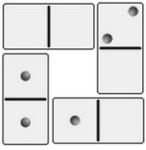Domino donuts
The purpose of this activity is for students to apply additive and multiplicative thinking to find three addends with the same sum.
This activity assumes the students have experience in the following areas:
- Adding many single digit numbers in sequence, fluently.
- Using logic to try out and eliminate possible answers.
The problem is sufficiently open ended to allow the students freedom of choice in their approach. It may be scaffolded with guidance that leads to a solution, and/or the students might be given the opportunity to solve the problem independently.
The example responses at the end of the resource give an indication of the kind of response to expect from students who approach the problem in particular ways.
Set of dominoes or printable dominoes
Here are three different domino donuts.

What do you notice about the number of dots on each side of a domino donut?
Find as many different domino donuts as you can with a full set of dominoes.
Is it possible to make a donut with a side total of two?
What is the highest side total that is possible?
The following prompts illustrate how this activity can be structured around the phases of the Mathematics Investigation Cycle.
Make sense
Introduce the problem. Allow students time to read it and discuss in pairs or small groups.
- Do I understand the situation and the words? (Students need to recognise that the total number of dots on each side of each donut share is the same.)
- Do you know what dominoes are in a full set?
- Do I expect there to be a pattern?
- What will my solution look like? (The solution will be many examples of domino donuts and possibly answers to the last two questions.)
- Will it be important to by systematic when trying out new possible donuts? Why?
Plan approach
Discuss ideas about how to solve the problem. Emphasise that, in the planning phase, you want students to say how they would solve the problem, not to actually solve it.
- What strategies will be useful to solve a problem like this? (Diagrams are a good way to record answers.)
- What tools will be useful? (Sets of dominoes make the problem more accessible.)
- Which dominoes are most likely to be in donuts? Why?
- Will any side totals be impossible? Which totals?
Take action
Allow students time to work through their strategy and find a solution to the problem.
- Have I shown my workings in an organised way?
- Are all my answers unique? Have I created the same donut more than once?
- Have I looked for ways to try sets of four dominoes?
- Which sets of four seem to work? Why?
- Which sets of four do not work? Why?
- Is there a pattern?
- How do my results look different or different to others? Why could this be?
- What ways have I tried to find all the possible donuts?
Convince yourself and others
Allow students time to check their answers and then either have them pair share with other groups or ask for volunteers to share their solution with the class.
- Is my working clear for someone else to follow?
- Did I try enough cases (donuts) to notice a pattern?
- What is the pattern?
- How would I convince someone else I am correct?
- Is my pattern expressed in a mathematical way? Does my pattern help me to find new donuts or check out if a set of four dominoes will work?
Examples of work
Work sample 1
The student calculates effectively to find if each side has the same sum. .
A procedural approach involves trying various combinations of dominoes to obtain a combination that gives the same side total. Usually students use the following procedure. Choose a starting domino and build onto that domino so the side totals are equal. 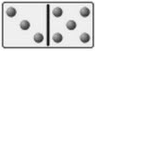
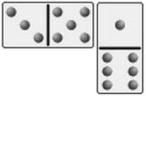
Choose a third domino to make the same side total than check if the fourth domino can be placed. 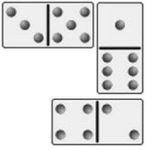
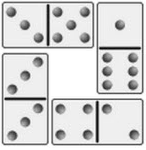
Students might also decide on a side total and attempt to find dominoes that will work. They will need to adopt a conceptual approach to finding the possible donuts.
Work sample 2
The student uses knowledge of all the dominoes in a six-dot set to find dominoes to match a given side total.
The set of possible dots is all the paired combinations of the numbers 0, 1, 2, 3, 4, 5, 6.
For a given side total a conceptual approach might go like this:
Take a side total of 12. That means that all four sides total 48 but the corners are counted twice.
Suppose the numbers 2, 3, 4, and 5 are selected to be the corner sets of dots. Those numbers total 14. Will that work? Subtracting 28 from 48 allows for the double counting of corners and gives 20. That means the numbers that go into the central position on each side total 20. Not all arrangements of 2, 3, 4, and 5 in the corners will work.
This approach can be applied to find the donut with the highest side total. The dominoes 6-6, 6-5, 5-5 and 6-4 have the greatest number of dots, 43 in total. To allow for double counting at the corners a number must be added to 43 to make a multiple of four. The highest possible corner numbers are 6, 6, 5, and 6 which equals 23. 43 + 23 = 66 which is not a multiple of four. However, 64 is a multiple of four so 6, 6, 4 and 5 may work with a side total of 64. Each side has 64 ÷ 4 = 16 dots. Playing around with the arrangement of 6, 6, 4 and 5 in the corners produces this donut that has the highest possible side total. 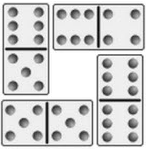
Similar thinking can be used to find if a side total of two is possible. That would give a total of eight with the corner numbers counted twice. The dominoes with the smallest number of dots are 0-0, 0-1, 1-1, 0-2. That is a total of five. Since the next multiple of four is eight, having three dots on the corners might work. The only way to do that is to have 0, 0, 1, and 2 at the corners. Playing around with arranging those numbers in the corners gives this donut. 